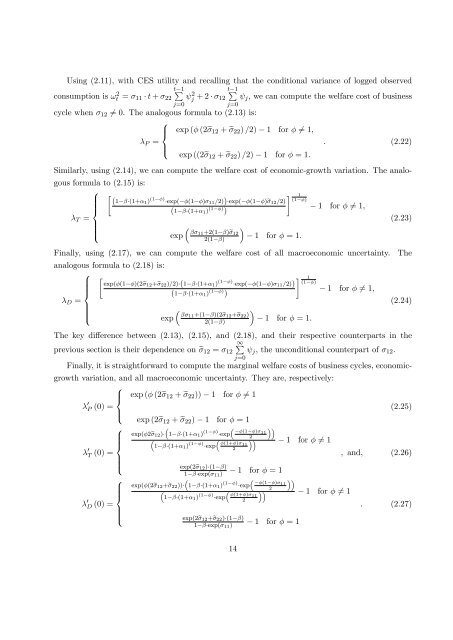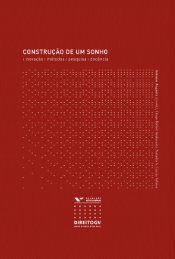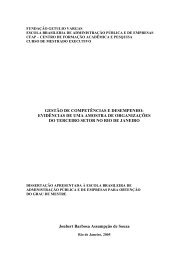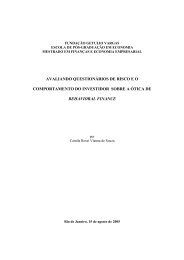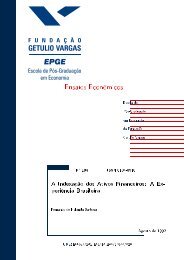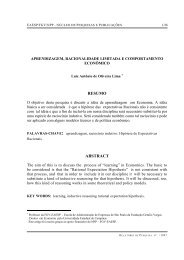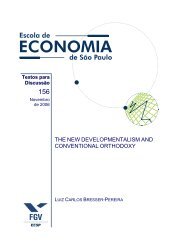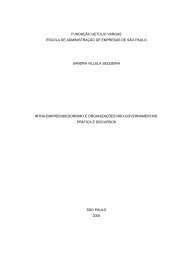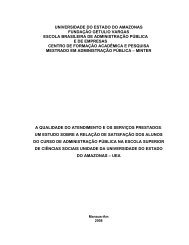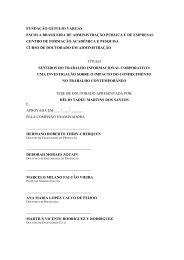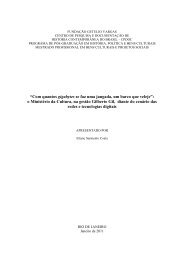Ensaios Econômicos - Sistema de Bibliotecas da FGV - Fundação ...
Ensaios Econômicos - Sistema de Bibliotecas da FGV - Fundação ...
Ensaios Econômicos - Sistema de Bibliotecas da FGV - Fundação ...
You also want an ePaper? Increase the reach of your titles
YUMPU automatically turns print PDFs into web optimized ePapers that Google loves.
Using (2.11), with CES utility and recalling that the conditional variance of logged observed<br />
consumption is ! t 2 tP<br />
1<br />
= 11 t + <br />
2 22 j + 2 tP<br />
1<br />
12 j, we can compute the welfare cost of business<br />
j=0<br />
cycle when 12 6= 0. The analogous formula to (2.13) is:<br />
8<br />
>< exp ( (2e 12 + e 22 ) =2) 1 for 6= 1,<br />
P =<br />
>:<br />
exp ((2e 12 + e 22 ) =2) 1 for = 1.<br />
j=0<br />
: (2.22)<br />
Similarly, using (2.14), we can compute the welfare cost of economic-growth variation. The analogous<br />
formula to (2.15) is:<br />
8<br />
><<br />
T =<br />
>:<br />
<br />
(1 (1+1 ) (1 ) exp( (1 ) 11 =2))exp( (1 )e 12 =2)<br />
(1 (1+ 1 ) (1 ) )<br />
<br />
exp<br />
11 +2(1 )e 12<br />
2(1 )<br />
1<br />
(1 )<br />
1 for = 1.<br />
1 for 6= 1,<br />
Finally, using (2.17), we can compute the welfare cost of all macroeconomic uncertainty.<br />
analogous formula to (2.18) is:<br />
8 <br />
><<br />
D =<br />
>:<br />
exp((1 )(2e 12 +e 22 )=2)(1 (1+ 1 ) (1 ) exp( (1 ) 11 =2))<br />
(1 (1+ 1 ) (1 ) )<br />
exp<br />
<br />
11 +(1 )(2e 12 +e 22 )<br />
2(1 )<br />
1<br />
(1 )<br />
1 for = 1.<br />
1 for 6= 1,<br />
(2.23)<br />
The<br />
(2.24)<br />
The key di¤erence between (2.13), (2.15), and (2.18), and their respective counterparts in the<br />
1P<br />
previous section is their <strong>de</strong>pen<strong>de</strong>nce on e 12 = 12 j, the unconditional counterpart of 12 .<br />
j=0<br />
Finally, it is straightforward to compute the marginal welfare costs of business cycles, economicgrowth<br />
variation, and all macroeconomic uncertainty. They are, respectively:<br />
8<br />
>< exp ( (2e 12 + e 22 )) 1 for 6= 1<br />
0 P (0) =<br />
(2.25)<br />
>:<br />
exp (2e 12 + e 22 ) 1 for = 1<br />
8<br />
<br />
<br />
exp(2e 12 ) 1 (1+ 1 ) (1 ) (1 )11<br />
exp<br />
2<br />
<br />
><<br />
0 1 (1+ 1 ) (1 ) (1+)11<br />
1 for 6= 1<br />
exp<br />
2<br />
T (0) =<br />
; and, (2.26)<br />
>:<br />
exp(2e 12 )(1 )<br />
1 exp( 11 )<br />
1 for = 1<br />
8<br />
<br />
<br />
exp((2e 12 +e 22 )) 1 (1+ 1 ) (1 ) (1 )11<br />
exp<br />
2<br />
<br />
><<br />
0 1 (1+ 1 ) (1 ) (1+)11<br />
1 for 6= 1<br />
exp<br />
2<br />
D (0) =<br />
: (2.27)<br />
>:<br />
exp(2e 12 +e 22 )(1 )<br />
1 exp( 11 )<br />
1 for = 1<br />
14


